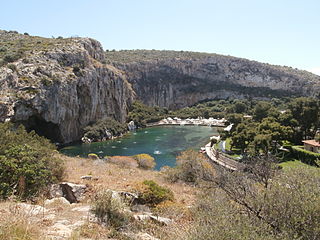
Corals are marine invertebrates within the class Anthozoa of the phylum Cnidaria. They typically form compact colonies of many identical individual polyps. Coral species include the important reef builders that inhabit tropical oceans and secrete calcium carbonate to form a hard skeleton.

The Australian pied cormorant, also known as the pied cormorant, pied shag, or great pied cormorant, is a medium-sized member of the cormorant family. It is found around the coasts of Australasia. In New Zealand, it is usually known either as the pied shag or by its Māori name of kāruhiruhi. Older sources may refer to it as the "yellow-faced cormorant".

A feral cat or a stray cat is an un-owned domestic cat that lives outdoors and avoids human contact: it does not allow itself to be handled or touched, and usually remains hidden from humans. Feral cats may breed over dozens of generations and become an aggressive local apex predator in urban, savannah and bushland environments. Some feral cats may become more comfortable with people who regularly feed them, but even with long-term attempts at socialization, they usually remain aloof and are most active after dusk.

The western mountain coati or western dwarf coati is a small procyonid, found in cloud forest and páramo at altitudes of 1,300–4,250 metres (4,270–13,940 ft) in the Andes of Colombia and Ecuador. A population discovered in the Apurímac–Cuzco region of southern Peru has tentatively been identified as the western mountain coati, but may represent an undescribed taxon.
A Regional Red List is a report of the threatened status of species within a certain country or region. It is based on the IUCN Red List of Threatened Species, an inventory of the conservation status of species on a global scale. Regional Red Lists assess the risk of extinction to species within a political management unit and therefore may feed directly into national and regional planning. This project is coordinated by the Zoological Society of London, the World Conservation Union (IUCN) and partners in national governments, universities and organizations throughout the world.

The eastern mountain coati or eastern dwarf coati is a small procyonid found in cloud forest and páramo at elevations of 2,000–4,000 m (6,600–13,100 ft) in the Andes of western Venezuela. Until 2009, it was included as a subspecies of the western mountain coati, but the eastern mountain coati is overall smaller, somewhat shorter-tailed on average, has markedly smaller teeth, a paler olive-brown pelage, and usually a dark mid-dorsal stripe on the back versus more rufescent or blackish, and usually without a dark mid-dorsal stripe in the western mountain coati. When the two were combined, they were classified as Data Deficient on the IUCN Red List but following the split the eastern mountain coati is considered endangered. A genetic analysis revealed that it should be regarded as a synonym of N. olivacea.

Nassarius concinnus is a species of sea snail, a marine gastropod mollusc in the family Nassariidae, the nassa mud snails or dog whelks.

Escalera's bat is a European bat in the genus Myotis, found in Spain, Portugal, and far southern France.

Cladocora caespitosa, commonly known as cushion coral, is a stony coral of the subclass Hexacorallia. This species forms the only true coral reef in the Mediterranean Sea.

Baía de Tarrafal or Tarrafal Bay is a bay of the Atlantic Ocean on the northwest coast of the island of Santiago in Cape Verde. The town of Tarrafal lies at its southeastern shore, and 643 m high Monte Graciosa rises from its northern shore. Most of its coast is rocky, but there is a stretch of beach near the city. The headland Ponta Preta marks the northwestern limit of the bay; there is a lighthouse on it.

For a small country, Albania is characterised by a considerable wealth of terrestrial and marine ecosystems and habitats with contrasting floral and faunal species, defined in an area of 28,748 square kilometres. Most of the country is predominantly of Mediterranean character, comprehending the country's center and south, while the alpine affinity is more visible in the northeast.

Lake Vouliagmeni is a small brackish-water lake fed by underground currents seeping through the mass of Mount Hymettus located to the south of Vouliagmeni, Greece.
Paranemonia vouliagmeniensis, or Greek anemone, is an endangered sea anemone that occurs only in Lake Vouliagmeni, Athens. The lake's status as a spa has contributed negatively to the species' livelihood and population; while no formal population monitoring has taken place, it has been estimated that the population has decreased by over 50% from 2007-2017. Paranemonia vouliagmeniensis has large embryos that can be found in the tentacles, unlike other species in the same genus. It also has a greater size range than other sea anemone.

The Zanclean flood or Zanclean deluge is a flood theorized to have refilled the Mediterranean Sea 5.33 million years ago. This flooding ended the Messinian salinity crisis and reconnected the Mediterranean Sea to the Atlantic Ocean, although it is possible that even before the flood there were partial connections to the Atlantic Ocean. The reconnection marks the beginning of the Zanclean age.

Actinia striata is a species of sea anemone endemic to the Mediterranean Sea.
The slender sea pen is a species of sea pen in the family Virgulariidae, occurring throughout the Mediterranean and Western Europe, with some colonies being found on islands in the Mid-Atlantic.














